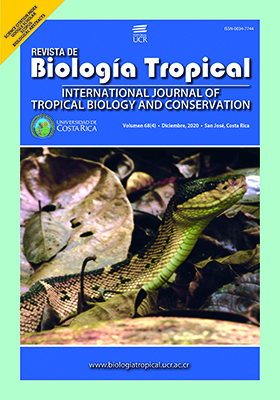Abstract
Introduction: North Pacific Costa Rica is generally considered rich in marine habitats and species. However, some areas are subject to fishing pressures that could degrade ecosystems. The Gulf of Papagayo comprises protected and unprotected areas with various degrees of impact. Objectives: Our aim was to evaluate the conservation status of fish and invertebrate communities in rocky reefs and sandy areas in two unprotected bays of the Gulf of Papagayo. Methods: The study was conducted at Cabuyal and Zapotillal Bays, south of Santa Rosa National Park. From December 2017 to April 2018, a total of thirty-five transects were done parallel to the coast at 3-10 m depth. We identified fish and invertebrate species and estimated biomass by trophic group in fish, and density in invertebrates. Results: We found a high number of species of fish (81) and invertebrates (70) in rocky reefs, which indicates a biodiverse ecosystem, but few species of fish in sandy areas. Species composition differed between the two bays. Density of juvenile fishes was high in Zapotillal Bay, suggesting that the area could be important for recruitment and breeding. Fish biomass was higher in sandy areas than in rocky reefs and all trophic groups had lower biomass than in other unprotected areas of the region. On average, reef fish biomass was 1.57 ± 0.67 (s.e.) t ha-1, similar to previous reports for Costa Rican North Pacific. By trophic group, piscivorous and planktivorous had the highest biomass in sandy areas and piscivorous and carnivorous in rocky reefs. Mean coral cover was low with 4.09 % ± 2.51 (s.e.), similar to previously reported for the region. Conclusions: Cabuyal and Zapotillal Bays in the Gulf of Papagayo are biodiverse in fish and invertebrates. However, the area may be impacted by local fisheries and other human activities, affecting fish and invertebrate populations, and coral formations. Our study fills some gaps in knowledge of marine biodiversity in the Gulf of Papagayo that can contribute to the conservation of marine life in North Pacific Costa Rica.
##plugins.facebook.comentarios##

This work is licensed under a Creative Commons Attribution 4.0 International License.
Copyright (c) 2020 Keilor Enrique Cordero Umaña, Cordero-Umaña, K., Pilár Santidrián Tomillo, Santidrián Tomillo, P.



